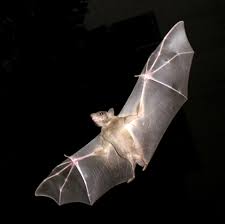 At Crossroads at Big Creek in the days leading up to Halloween, we talk a lot about skeletons. Skeletons……..and bats. Curiously, the human skeletons which are depicted in decorations this time of year, and the skeletons of bats are almost identical…..except for the length of the bones.
At Crossroads at Big Creek in the days leading up to Halloween, we talk a lot about skeletons. Skeletons……..and bats. Curiously, the human skeletons which are depicted in decorations this time of year, and the skeletons of bats are almost identical…..except for the length of the bones.
We humans walk upright so we have long, strong leg bones. The leg bones of bats are wimpy. But then, humans hands are comparatively small. Bat hands are enormous.
You probably know what a bat’s wing looks like, and if you don’t you can look at a Halloween card on napkin. A bat’s wing actually is its arm and hand. At the top of the wing, right at the bend, is a little hook. That is the bat’s thumb. What we would call the index finger it the edge of the wing and the other three fingers act as bracing for the extremely thin wing membranes that stretch down to the feet.
By moving their arms, fingers and feet, bats can fly, and they do so extremely well. And because they fly so well, they are able to catch and eat flying insects.
Bats can hear must better than humans. They locate their prey by making high-pitched sounds. When the sounds hit an insect and pounce back, the bat can tell exactly where the insect is. And because they hunt by sound, they can locate their prey in the dark.
If you see very small bats flying, they are probably just that….small bats. People rarely see baby bats. Most young bats just hang upside down while their mothers fly off to hunt each night. Some baby bats are born with special baby teeth with tiny hooks. With these special teeth, a baby bat can cling it its mother’s teat, even when she is flying. (Sounds to me like it might hurt)
Many people are afraid of bats and I don’t suppose Halloween legends help any. Maybe if people understood how many destructive moths and annoying mosquitoes these creature it, they would appreciate creatures of the night.
Speaking of those that are most active after dark, The Door Peninsula Astronomical Society invites the community to its November Meeting at 7:00 pm, Tuesday, November 3 at the Stonecipher Astronomy Center. Dr. John Beck will present “Update on the New Horizon Mission” which will focus on the amazing images which our coming in from our favorite dwarf planet, Pluto. Refreshments will be served. Meet at the Stonecipher Astronomy Center, 2200 Utah in Sturgeon BayOn Wednesday, Nov. 4 at 7:00 The Climate Change Coalition of Door County will screen the Ememy Award winning documentary Chasing Ice in the Lecture Hall of the Collins Learning Center.
Chasing Ice is the story of environmental photographer James Balog, who in 2005 headed to the Arctic on a tricky assignment for National Geographic: to capture images to help tell the story of the Earth’s changing climate. Even with a scientific upbringing, Balog had been a skeptic about climate change, but that first trip north opened his eyes to the biggest story in human history.
Bruce Smith, atmospheric education resource agent for the American Meteorological Society and a meteorology instructor for the University of Wisconsin Colleges, will be moderator for the evening. The program is free and open to the public.
Crossroads is a donor support preserve welcoming learners of all ages to programs in science, history and the environment. The Collins Learning Center, located a 2041 Michigan is open 2:00-4:30 daily and during scheduled activities.
Wednesday, November 4
7:00 The Climate Change Coalition Film Screening: Chasing Ice
Chasing Ice is the story of environmental photographer James Balog, who in 2005 headed to the Arctic on a tricky assignment for National Geographic: to capture images to help tell the story of the Earth’s changing climate. Even with a scientific upbringing, Balog had been a skeptic about climate change, but that first trip north opened his eyes to the biggest story in human history.
Within months of that first trip to Iceland, the photographer conceived the boldest expedition of his life — the Extreme Ice Survey. With a band of young adventurers in tow, Balog began deploying revolutionary time-lapse cameras across the brutal Arctic to capture a multi-year record of the world’s changing glaciers.
Bruce Smith, atmospheric education resource agent for the American Meteorological Society and a meteorology instructor for the University of Wisconsin colleges, will be moderator for the evening. Lecture Hall of the Collins Learning Center.The program is free and open to the public.
.
\.

